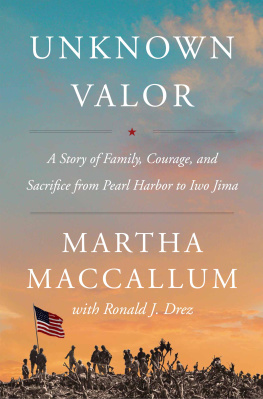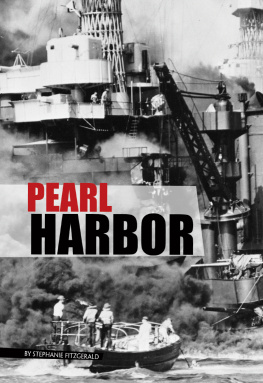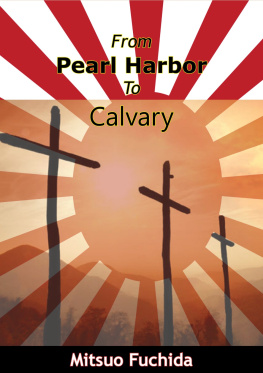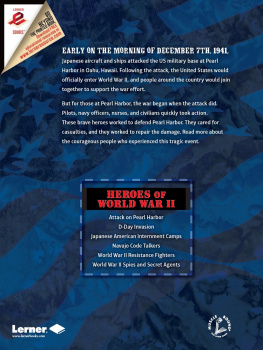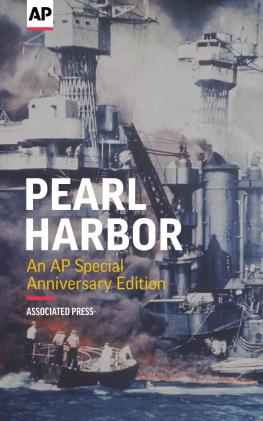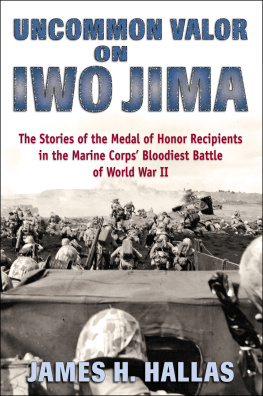Martha MacCallum - Unknown Valor: A Story of Family, Courage, and Sacrifice from Pearl Harbor to Iwo Jima
Here you can read online Martha MacCallum - Unknown Valor: A Story of Family, Courage, and Sacrifice from Pearl Harbor to Iwo Jima full text of the book (entire story) in english for free. Download pdf and epub, get meaning, cover and reviews about this ebook. year: 2020, publisher: HarperCollins, genre: History. Description of the work, (preface) as well as reviews are available. Best literature library LitArk.com created for fans of good reading and offers a wide selection of genres:
Romance novel
Science fiction
Adventure
Detective
Science
History
Home and family
Prose
Art
Politics
Computer
Non-fiction
Religion
Business
Children
Humor
Choose a favorite category and find really read worthwhile books. Enjoy immersion in the world of imagination, feel the emotions of the characters or learn something new for yourself, make an fascinating discovery.
- Book:Unknown Valor: A Story of Family, Courage, and Sacrifice from Pearl Harbor to Iwo Jima
- Author:
- Publisher:HarperCollins
- Genre:
- Year:2020
- Rating:5 / 5
- Favourites:Add to favourites
- Your mark:
- 100
- 1
- 2
- 3
- 4
- 5
Unknown Valor: A Story of Family, Courage, and Sacrifice from Pearl Harbor to Iwo Jima: summary, description and annotation
We offer to read an annotation, description, summary or preface (depends on what the author of the book "Unknown Valor: A Story of Family, Courage, and Sacrifice from Pearl Harbor to Iwo Jima" wrote himself). If you haven't found the necessary information about the book — write in the comments, we will try to find it.
Martha MacCallum: author's other books
Who wrote Unknown Valor: A Story of Family, Courage, and Sacrifice from Pearl Harbor to Iwo Jima? Find out the surname, the name of the author of the book and a list of all author's works by series.
Unknown Valor: A Story of Family, Courage, and Sacrifice from Pearl Harbor to Iwo Jima — read online for free the complete book (whole text) full work
Below is the text of the book, divided by pages. System saving the place of the last page read, allows you to conveniently read the book "Unknown Valor: A Story of Family, Courage, and Sacrifice from Pearl Harbor to Iwo Jima" online for free, without having to search again every time where you left off. Put a bookmark, and you can go to the page where you finished reading at any time.
Font size:
Interval:
Bookmark:

For Dan, Elizabeth, Reed, and Harry
Among the Americans who served on Iwo Island, uncommon valor was a common virtue.
Admiral Chester W. Nimitz
Greater love than this no man hath, said Our Savior, that a man lay down his life for his friends. And the soldier who dies to save his brothers, and to defend the hearths and altars of his country, reaches this highest of all degrees of charity.
Cardinal Merciers Pastoral Letter, as quoted by G. B. Erskine, Major General Commanding, 3rd Marine Division
So long as the sun shall warm the earth, let no Christian be so bold as to come to Japan; and let all know that... if he violate this command, [he] shall pay for it with his head.
Imperial inscription at mass grave site of Christians
I ts almost impossible to understate how little Americans knew about Japan before World War II.
In 1853, the empire of Japan was only known to the civilized world as a shadowy, mist-covered island kingdom somewhere east of China. There lived fierce warriors who brooked no intrusion from outside. Their quarantine was absolute. No one had pried open their door, although many had tried. Marco Polo had regaled his Venetian audiences with enchanting tales of a great island to the east of Cathay. It was 1295, and the explorer beguiled enraptured listeners with tales of that enigmatic, alluring place. They imagined the equivalent of the Lost Continent of Atlantis, the Fountain of Youth, or the Seven Cities of Cibola. Explorers and merchants sought to lift the veil on the Japanese kingdom, but all failed. Even the great armies of Kublai Khan, who had overrun the rest of Asia and terrorized Europe, had been hurled back in defeat when they had dared to storm the Japanese wall.
Only faith had opened the door, and only a little. Jesuit, Dominican, and Franciscan missionaries had been allowed entry in the 1500s. They had baptized more than 200,000 Japanese as Christians. But in 1639, the door had slammed shut. The imperial establishment deemed Christianity a threat, and the backlash was brutal. Crucifixions, beheadings, and burnings at the stake laid waste to what was seen as heresy against the rulers. When the last Christians had been murdered, the black curtain of absolute exclusion and secrecy again shrouded Japan. The Dutch were permitted a small trading post as a reward for having participated in the persecution, using their enormous cannons to batter down the walls of their fellow Christians strongholds.
In 1831, a Japanese vessel sailing the eastern Pacific Ocean was engulfed by the wind and waves of a great storm. The battered vessel did not sink but was blown way off course. The crippled ship made landfall near the Columbia River on the coast of the Washington Territory of the United States. Local British and American settlers saved seven desperate Japanese seamen, but a return to their homeland, seven thousand miles away, was hopeless. They lived in exile in North America for six years. In 1837, an opportunity arose: a trading voyage was sailing to a small island off the coast of China. The homesick Japanese seamen would be taken to their motherland, ferried there by humanitarian Americans. The US government believed that the gesture would help soften the Japanese intransigence and pave the way to trade.
The final run to Japan from the island off the Chinese coast would be made by the USS Morrison, specially outfitted for the mission. To ensure that there would be no misunderstanding on the part of the Japanese that it was a peaceful approach, all of Morrisons guns were removed. As the ship sailed for Japan and slowly entered the forbidden waters of Tokyo Bay, a fleet of Japanese junks appeared as out of nowhere, swarming the ship like moths around a flame. Waves slapped the sides of the ship as the American crew eyed the men bobbing below on the exotic fleet of painted boats with accordion sails of maroon and ocher. They felt a thousand eyes on them from the shore as well. Silence hovered around them. As it became clear that Morrison was unarmed, Japanese batteries opened fire from the shore. Morrison hastily unfurled more sail, moving to another anchorage off the island of Kyushu, but the batteries, firing unrelentingly, found them there as well. Defenseless, the Americans turned tail, leaving the hostile waters behind like so many before them. The long-lost Japanese sailors were still on board, tainted by foreign soil and now considered worthless to their homeland.
Nine years later, President James K. Polk would try his luck. In 1846, Polk sent Commodore James Biddle with two ships on a mission to open trade with Japan. This time, there was to be no peace offering. Biddle would enter Tokyo Bay on the ninety-gun Columbus, the corvette Vincennes by its side, in an impressive show of US force and firepower.
The ships entrance into the bay was greeted by swarming primitive Japanese boats loaded with hostile warriors. Vincennes was promptly boarded and proclaimed a Japanese possession. Biddles request to go ashore and meet with the imperial ministers was flatly denied. For ten days, Biddle would stay anchored, leaving his ship only to make repeated demands to see the proper authorities. For ten days the Japanese declined.
Defeated, Biddle prepared to depart. As he stepped from a Japanese junk onto his own captains barge, a Japanese sailor shoved him, sending him sprawling to the bottom of his own boat. Japanese officers feigned shock at the disrespect but simply looked on.
Two years later, the United States and Japan would meet again. In June 1848, sixteen American sailors on the whaler Lagoda jumped ship off the coast of Japan to escape the treatment of a cruel captain. Staggering ashore on Japanese soil, they quickly realized that they had jumped from the frying pan into the fire. The Japanese arrested and imprisoned them. Close confinement was their fate, and they were forced to humiliate themselves by desecrating a Christian cross and crucifixes.
Eight months later, Captain James Glynn mounted a rescue expedition to liberate the captives. On board his sixteen-gun sloop, USS Preble, Glynn sailed into Japanese waters and was greeted with the now-familiar unwelcoming party of warriors signaling him to turn and leave. Undaunted, Preble bowled through the Japanese boats like a rampaging bull and beat them to a more favorable anchorage near the shoreline.
When the outraged Japanese finally caught up to him, they disembarked and mounted the high ground overlooking the bay, which bristled with sixty cannons. As they trained the guns on Preble, Captain Glynn was unimpressed. He stood tall on his deck and with his booming voice demanded the release of the imprisoned Americans.
The Japanese scoffed and reminded Glynn of the humiliation they had inflicted on the proud Commodore Biddle. Glynn was not to be pushed around, and from his lofty perch, he hurled insults and invectives back at them. The bravado seemed to stun those within the sound of his voice. Seizing on their momentary disorientation, Glynn forcefully demanded the prisoners release and proclaimed that the United States had not only the power to protect its citizens but the will to use it.
All beheld the stunning scene. The moments passed slowly, and then the prisoners, one by one, surrounded by their guards, made their way down the winding hill toward Glynn. The triumphant American captain postured on the deck of his sloop and sailed away homeward with his crew.
Font size:
Interval:
Bookmark:
Similar books «Unknown Valor: A Story of Family, Courage, and Sacrifice from Pearl Harbor to Iwo Jima»
Look at similar books to Unknown Valor: A Story of Family, Courage, and Sacrifice from Pearl Harbor to Iwo Jima. We have selected literature similar in name and meaning in the hope of providing readers with more options to find new, interesting, not yet read works.
Discussion, reviews of the book Unknown Valor: A Story of Family, Courage, and Sacrifice from Pearl Harbor to Iwo Jima and just readers' own opinions. Leave your comments, write what you think about the work, its meaning or the main characters. Specify what exactly you liked and what you didn't like, and why you think so.

